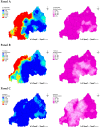Mapping Soil-Transmitted Helminth Parasite Infection in Rwanda: Estimating Endemicity and Identifying At-Risk Populations
- PMID: 31207897
- PMCID: PMC6630518
- DOI: 10.3390/tropicalmed4020093
Mapping Soil-Transmitted Helminth Parasite Infection in Rwanda: Estimating Endemicity and Identifying At-Risk Populations
Abstract
Soil-transmitted helminth (STH) infections are globally distributed intestinal parasite infections caused by Ascaris lumbricoides, Trichuris trichiura, and hookworms (Ancylostoma duodenale and Necator americanus). STH infection constitutes a major public health threat, with heavy burdens observed in many of the world's tropical and subtropical regions. Mass drug administration and sanitation improvements can drastically reduce STH prevalence and associated morbidity. However, identifying targeted areas in need of treatment is hampered by a lack of knowledge on geographical and population-level risk factors. In this study, we applied Bayesian geostatistical modelling to data from a national school-based STH infection survey in Rwanda to (1) identify ecological and population-level risk factors and (2) provide comprehensive precision maps of infection burdens. Our results indicated that STH infections were heterogeneously distributed across the country and showed signatures of spatial clustering, though the magnitude of clustering varied among parasites. The highest rates of endemic clustering were attributed to A. lumbricoides infection. Concordant infection patterns among the three parasite groups highlighted populations currently most at-risk of morbidity. Population-dense areas in the Western and North-Western regions of Rwanda represent areas that have continued to exhibit high STH burden across two surveys and are likely in need of targeted interventions. Our maps support the need for an updated evaluation of STH endemicity in western Rwanda to evaluate progress in MDA efforts and identify communities that need further local interventions to further reduce morbidity caused by STH infections.
Keywords: Ascaris lumbricoides; Rwanda; Trichuris trichiura; hookworm; soil-transmitted helminth; spatial epidemiology.
Conflict of interest statement
The END Fund supported STH remapping through SCI at Imperial College London and provided a research grant to the University of Queensland for additional data analysis and reporting. The funders had no role in study design, data collection and analysis, decision to publish, or preparation of the manuscript.
Figures





Similar articles
-
Spatiotemporal distribution and population at risk of soil-transmitted helminth infections following an eight-year school-based deworming programme in Burundi, 2007-2014.Parasit Vectors. 2017 Nov 23;10(1):583. doi: 10.1186/s13071-017-2505-x. Parasit Vectors. 2017. PMID: 29169386 Free PMC article.
-
Co-morbidity of malaria and soil-transmitted helminths in Nigeria: a joint Bayesian modelling approach.Infect Dis Poverty. 2025 Apr 2;14(1):28. doi: 10.1186/s40249-025-01276-x. Infect Dis Poverty. 2025. PMID: 40170071 Free PMC article.
-
Efficacy of Single-Dose Albendazole for the Treatment of Soil-Transmitted Helminthic Infections among School Children in Rwanda-A Prospective Cohort Study.Pharmaceuticals (Basel). 2023 Jan 17;16(2):139. doi: 10.3390/ph16020139. Pharmaceuticals (Basel). 2023. PMID: 37259291 Free PMC article.
-
Efficacy of single-dose 500 mg mebendazole in soil-transmitted helminth infections: a review.J Helminthol. 2018 May;92(3):269-278. doi: 10.1017/S0022149X17000426. Epub 2017 Jul 18. J Helminthol. 2018. PMID: 28716158 Review.
-
Prevalence and Risk Factors of Soil-Transmitted Helminthic Infections in the Pediatric Population in India: A Systematic Review and Meta-Analysis.J Lab Physicians. 2022 Aug 17;15(1):4-19. doi: 10.1055/s-0042-1751319. eCollection 2023 Mar. J Lab Physicians. 2022. PMID: 37064993 Free PMC article. Review.
Cited by
-
Geo-Mapping of Intestinal Parasitic Infection in a Southern Community in Nigeria.Ethiop J Health Sci. 2024 May;34(3):203-210. doi: 10.4314/ejhs.v34i3.5. Ethiop J Health Sci. 2024. PMID: 40438451 Free PMC article.
-
Risk mapping and socio-ecological drivers of soil-transmitted helminth infections in the Philippines: a spatial modelling study.Lancet Reg Health West Pac. 2023 Nov 22;43:100974. doi: 10.1016/j.lanwpc.2023.100974. eCollection 2024 Feb. Lancet Reg Health West Pac. 2023. PMID: 38076323 Free PMC article.
-
A systematic review and guide for using multi-response statistical models in co-infection research.R Soc Open Sci. 2024 Oct 4;11(10):231589. doi: 10.1098/rsos.231589. eCollection 2024 Oct. R Soc Open Sci. 2024. PMID: 39371046 Free PMC article.
-
Optimizing Implementation of Preventive Chemotherapy against Soil-Transmitted Helminthiasis and Intestinal Schistosomiasis Using High-Resolution Data: Field-Based Experiences from Côte d'Ivoire.Diseases. 2022 Sep 20;10(4):66. doi: 10.3390/diseases10040066. Diseases. 2022. PMID: 36278565 Free PMC article.
-
Anemia and undernutrition in intestinally parasitized schoolchildren from Gakenke district, Northern Province of Rwanda.PLoS One. 2022 Jan 6;17(1):e0262361. doi: 10.1371/journal.pone.0262361. eCollection 2022. PLoS One. 2022. PMID: 34990483 Free PMC article.
References
-
- Ortu G., Assoum M., Wittmann U., Knowles S., Clements M., Ndayishimiye O., Basáñez M.-G., Lau C., Clements A., Fenwick A., et al. The Impact of an 8-Year Mass Drug Administration Programme on Prevalence, Intensity and Co-Infections of Soil-Transmitted Helminthiases in Burundi. Parasites Vectors. 2016;9:513. doi: 10.1186/s13071-016-1794-9. - DOI - PMC - PubMed
Grants and funding
LinkOut - more resources
Full Text Sources

